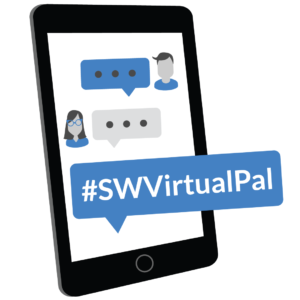Navigating AI in Social Work Education
Editor’s note: In this blog post, four social worker educators share a sample from their new and free resource about using Artificial Intelligence (AI) in social work education. Alexander Rubin, LCSW, is a clinical assistant professor based in field education at the University at Buffalo School of School of Social Work. He specializes in community partnership development, field-specific teaching, and innovation in field education. Michael Lynch, LMSW, is a clinical associate professor at the University at Buffalo School of Social Work. He specializes in experiential learning, community partnerships, and the use of technology in social work practice and education. Todd Sage, Ph.D., MSW, is a clinical associate professor at the University at Buffalo School of Social Work. He is the chemical dependency track coordinator and mental health track chair. He researches technology and child welfare and enjoys integrating emerging technologies in the classroom and as a field instructor. Melanie Sage, Ph.D., LCSW, is a tech consultant for universities, social work departments, and social work agencies. She is an expert in generative AI, machine learning in social work, social media use, online education, and teaching with technology. She also works with agencies to train staff in Motivational Interviewing.
As social work educators, we find ourselves at a point where the capabilities of generative artificial intelligence (AI) tools like ChatGPT intersect with our professional practice more and more often, and we ponder these challenges with much philosophical debate in academic settings. But we send our students out to their practicum sites, and the debates are no longer philosophical; real-life decisions affect agencies, students, and clients, and these challenges must be thoughtfully and practically addressed. The emergence of AI has outpaced the development of comprehensive policy in numerous professional settings. This is why we wrote an article to offer guidance and considerations for the social work field educator with a student placed in their agency. Our goal is to introduce use cases, debates, and potential policies. The full article can be downloaded here and shared with your local social services agencies.
Using Artificial Intelligence in Social Work Field Education
Editor’s Note: Jacqueline Jones is the MSW Field Coordinator at the University of Alabama at Birmingham and one of my colleagues in the UAB Department of Social Work. She has over six years of experience supervising students during field placements and eight years of social work practice experience. In this blog post, she shares how she uses artificial intelligence tools to improve her teaching and save time.
I think, in many ways, social workers shy away from technology and, seemingly, advanced computer systems. In an ever-evolving world where social media, email, and searching the World Wide Web are literally at our fingertips, I believe social workers should embrace the use of technology in their practice and what it is capable of doing to help not only us but our clients, too.
I will expand on using one specific realm of technology in social work education: artificial intelligence or AI. Currently, I serve as the Masters of Social Work (MSW) Field Coordinator at the University of Alabama at Birmingham, which means teaching seminar courses for field education. This semester, I decided to use AI to assist me in developing in-class activities for my MSW students.
What is AI? Here is the answer that ChatGPT gave me in a matter of seconds to give you a glimpse of what AI can do.
Technology Disruption Readiness Plan: A Best Practice for the Social Work Classroom
In social work education, one lesson we can take away from the COVID pandemic has brought many lessons to social work education is to be ready when a crisis or disruption requires an instructor and students to quickly shift an entire course, a class session, or even an assignment. In today’s world, this typically means understanding when and how to adapt our learning environments to incorporate or adjust for digital technologies, both hardware (i.e., portable devices, laptops, WiFi access) and software (i.e., learning management systems). A social work educator can prepare for future disruption in their classroom by developing a course-level Technology Disruption Readiness Plan. Such a plan aims to thoughtfully and systematically think through how one will manage disruptions due to technology to the educational process and then share this information with students. This approach is recommended in the NASW Standards for Technology in Social Work Practice under Standard 4.06 Technological Disruptions, which focuses on what to do when technology fails with online teaching, such as a power outage or a laptop failure. It is easy to transfer this idea to other forms of educational disruption, including situations unique to an individual (i.e., serious illness and military deployment) or community-level crises such as natural disasters. Further, the disruptions occur with instructors as well, and having a plan to hand off one’s class to another instructor can make the transition less traumatic for you and your students.
Using LinkedIn for #SWVirtualPal
Editor’s note: This post is cross-published on the Social Work Virtual Pal website. Social Work Virtual Pal is a global and virtual community of practice for the social work profession, that digitizes the practice of having a pen pal for professional learning and networking. This community focuses on connection and collaboration among social workers to offer the profession with an opportunity to harness its collective knowledge for the greater good. We have resources for social work educators so, please consider incorporating #SWVirtualPal in your social work course. Learn about Social Work Virtual Pal here.
Social Work Virtual Pal now has a LinkedIn Group for social work students, instructors, and practitioners to connect with other social workers around the world. Similar to our Twitter account, this is a virtual space that digitizes the practice of having a pen pal for professional learning and networking. In addition, this community focuses on connection and collaboration among social workers to offer the profession an opportunity to harness its collective knowledge for the greater good. In this blog post, we offer details for creating a LinkedIn Profile, establishing your digital networking goals, and then joining our LinkedIn Group to find your #SWVirtualPal.
Where to start
LinkedIn is a social networking site designed specifically for professional use and offers a robust user profile system that serves as a digital resume. It is a great place to establish your online presence as a social work student or practitioner. As with any social media platform, you’ll want to start with creating your LinkedIn profile. There are many online tutorials on creating a high-quality LinkedIn profile, and LinkedIn’s Help feature offers many tips and guides on navigating the platform. Before getting started with your profile, you will want to have a professional-looking photo and a copy of your resume handy. Set aside a few hours to create your profile. Here is a good profile checklist designed for college students, but applicable to anyone.
Because #SWVirtualPal is designed to help social workers from around the world connect with other social workers, there are some additional features to consider adding to your profile:
Writing your values-based teaching philosophy
This blog post is one of a three-part series about how to write a values-based teaching philosophy. In this blog post, we (April Love and Laurel Hitchcock) cover tips for writing and presenting a values-based teaching philosophy. The first post offers a process for identifying your teaching values and in the third post, we share our own values-based teaching philosophies. This post is cross-published on April’s Blog – Genuine Curiosity: Navigating Nursing Education Now.
If you are reading this blog post, then you have already done some work to identify your teaching values – see our first blog post – How to define your Teaching Values. We know you’ve worked hard and put in the time to truly identify teaching values that speak to the heart and practice of your professional identity. You’ve reviewed, compared, and reflected on various teaching values and now feel confident that those you’ve selected represent you well and that you’re ready to share them with others.
In addition to identifying your teaching values, you’ve also spent some time collecting “evidence” as to how these values are showing up in your work. Maybe you have a special process that encourages students to speak freely in your classroom, which is a great example of how you’re living the value of “safety” or “inclusion.” Maybe it’s a new technology that you’ve introduced to your department that has you leading the charge for “innovation” or “creativity.” Whatever those examples are that showcase how you’re walking the walk and talking the talk, you’ll want to display them in your teaching philosophy. Actions often speak louder than words.
Now is the time to transform your values and evidence into a two-page written statement of teaching philosophy that you can share with others in a variety of ways depending on your audience and other environmental considerations.
Developing a Personalized Social Media Policy for Social Work Practice
Editor’s Note: This blog post is adapted from the Second Edition of the Social Media Toolkit for Social Work Field Educators.
There are many reasons for social workers to have a personalized social media policy – to maintain boundaries, protect privacy and confidentiality, and model professional behavior. To be clear, I am not referring to the policy that your organization or institution might have, directing the faculty, staff, and students on when it is okay to use social media, but one that you develop and follow as an individual practitioner, student, and/or educator. The purpose of a social media policy is to inform clients, students, colleagues, and others about when, how, and why you use social media in a professional capacity. From an ethical lens, this is a recommended practice per National Association of Social Worker’s (NASW) Technology in Social Work Practice Standard 2.10 – Social Media Policy and fits with the NASW Code of Ethics standards of informed consent with clients (1.3e-i), respect with colleagues (2.1), and when conducting supervision and consultation (3.1).
The following steps provide a guide for developing a social media policy that can be used as an assignment in a classroom with students or adapted for practitioners:






